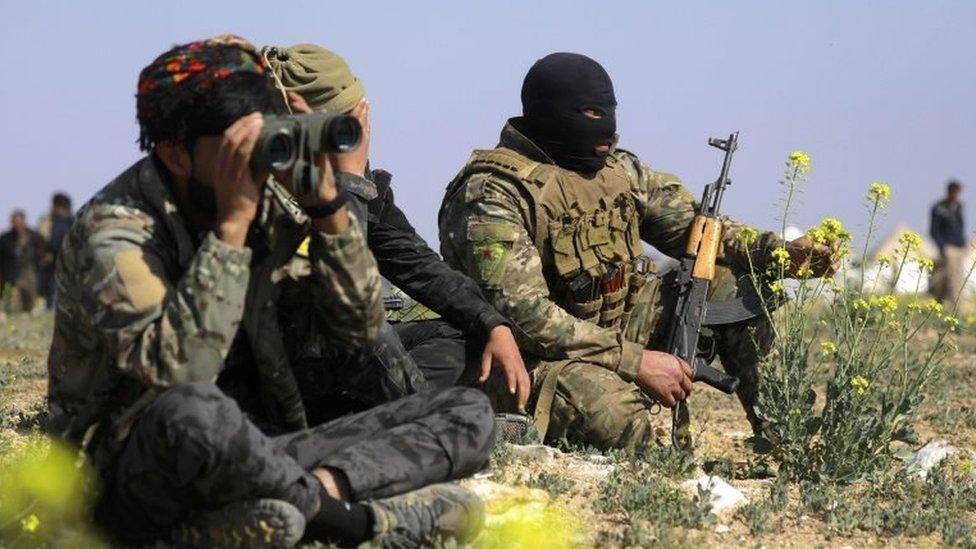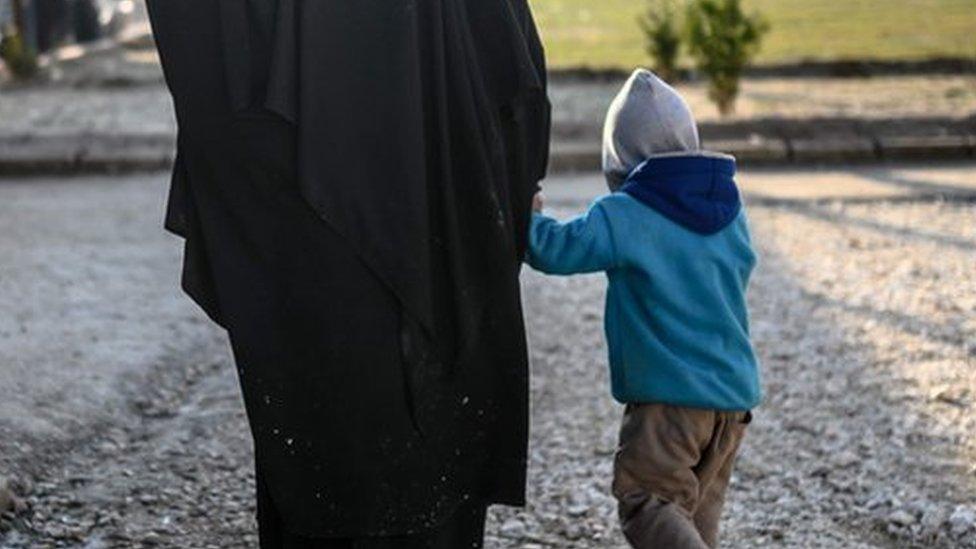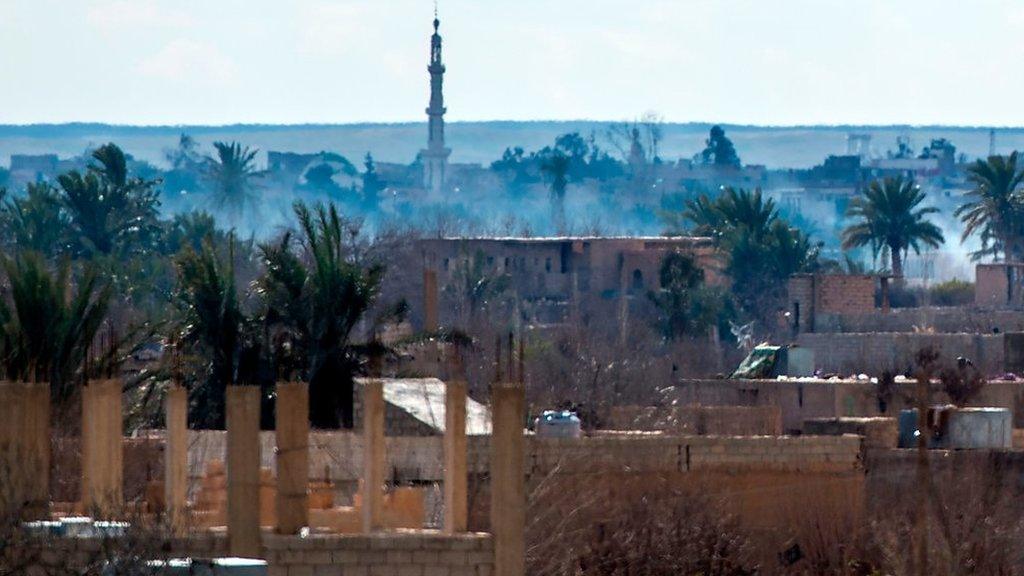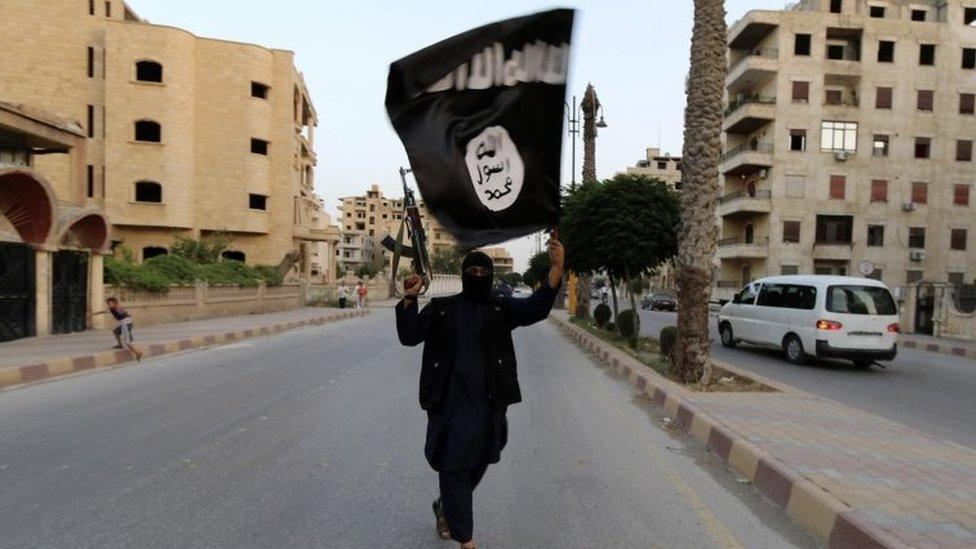Syria war: US to leave 200 troops for peacekeeping after withdrawal
- Published

A US-backed alliance is waiting to evacuate civilians before launching its final assault on IS militants in Syria
The US military will keep 200 troops in Syria to serve as a peacekeeping force after it pulls out most of its soldiers, the White House says.
President Donald Trump has come under fierce criticism for his decision last December to withdraw 2,000 troops.
He said the Islamic State group (IS) had been "defeated", but critics warn the group has not disappeared entirely.
The latest announcement comes as the battle to turf IS out of the last pocket it holds in Syria continues.
US-backed fighters belonging to the Syrian Democratic Forces (SDF) alliance are making fresh attempts to evacuate civilians from Baghuz, a village in eastern Syria on the Iraqi border.
An estimated 300 IS fighters are thought to be holed up inside a tiny pocket of land.
Why now?
President Trump's announcement of a rapid withdrawal in late December took US allies and his own military and defence advisers by surprise back in late December. It prompted concerns that Turkey could attack Kurdish forces, who have been working with the US to battle IS in Syria.
US officials said American forces were initially given 30 days to leave Syria, but Mr Trump later said the withdrawal would be slowed down.
Speaking at a press conference on Thursday, White House spokeswoman Sarah Sanders said: "A small peacekeeping group of about 200 will remain in Syria for a period of time."
Republican Senator Lindsey Graham, who was a vocal opponent of the withdrawal decision, praised Mr Trump's latest move and said the troops would work "as part of an international stabilising force".
US troops currently have a presence in a network of bases and airstrips in an arc across north-eastern Syria.

A temporary reprieve - but still falls short
By Jonathan Marcus, BBC defence correspondent
This shift in the US position may to some extent reassure its Kurdish allies and help to keep some small elements of allied troops and special forces on the ground.
The troops have been described as "peacekeepers" by the White House but they clearly will be helping to keep the Kurdish forces credible and linking them up to US air power if necessary.
Ostensibly this is about preventing the resurgence of IS and it also prevents an even deeper push into Syria by the Turks.
But the fact that one of the two remaining US bases will be in the south east, near to Syria's border with Iraq and Jordan, shows that countering Iranian influence remains one of the central guiding principles of the US approach.
However, this still falls far short of a comprehensive strategy for the future of Syria or the region and, for Washington's Kurdish allies, may just be a temporary blessing.

What's the latest in the battle against IS?
The SDF alliance has IS militants surrounded in their final populated stronghold in Syria, but says it has delayed its final attack to allow remaining civilians to be evacuated.
A convoy of about 30 trucks was seen carrying mainly women and children out of the area on Friday, but the SDF warns that thousands of civilians remain.

Thousands of people living under IS in Baghuz have fled the fighting in recent days and weeks
Some 20,000 civilians are estimated to have already fled the area in recent weeks, but these departures stalled earlier this week.
Most have been taken by the SDF to a makeshift camp for displaced people in Hassakeh province, north-eastern Syria. Among them are the wives and children of IS militants and many foreign nationals.
They include British teenager Shamima Begum and American woman Hoda Muthana, who are both in limbo after being told by their respective governments they no longer have citizenship.


Separately, the jihadist group said it was behind a car bomb attack at an oil field 100 miles north of Baghuz, which killed at least 13 people, including SDF soldiers, on Thursday.
The fall of the last IS territorial stronghold in Syria is significant - but experts have warned the group's ideological pull endures.
At its height, five years ago, IS controlled 88,000 sq km (34,000 sq miles) of territory stretching from western Syria to eastern Iraq.

- Published21 February 2019

- Published23 March 2019

- Published19 February 2019
